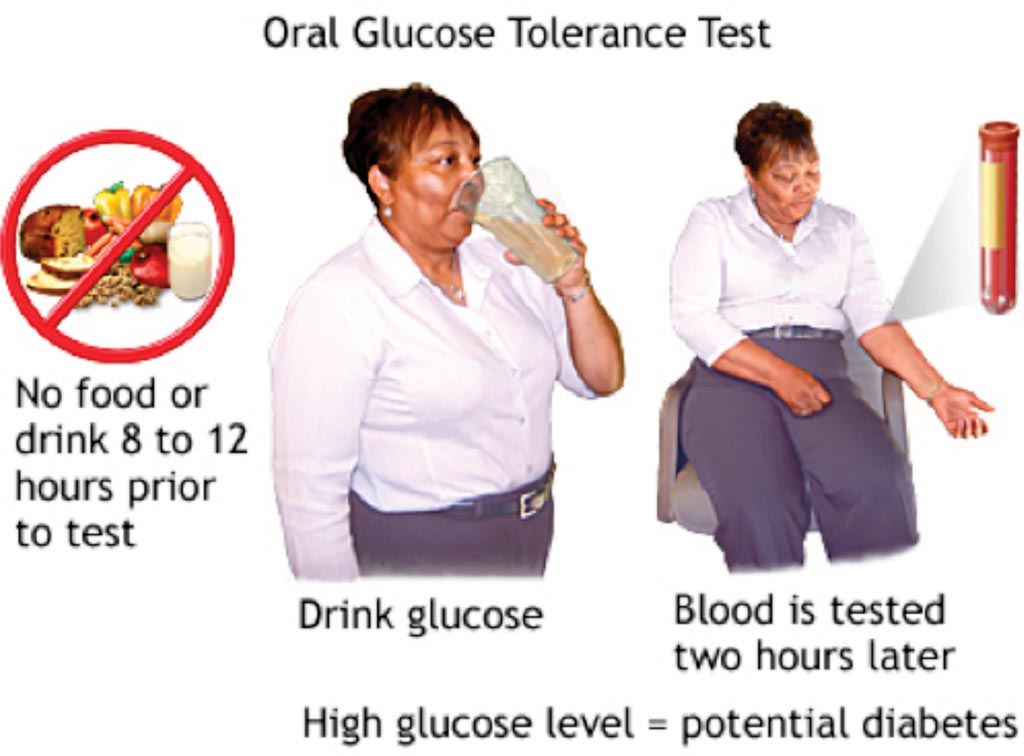Diagnostic Accuracy Demonstrated in Oral Glucose Tolerance Test
By LabMedica International staff writers
Posted on 02 Jan 2019
The incidence of overweight and obesity among children has increased dramatically in recent decades, with about one-third of children in the USA currently being either overweight or obese. Being overweight in early childhood increases risk for later obesity.Posted on 02 Jan 2019
During an oral glucose tolerance test (OGTT), morphological features of the glucose curve, monophasic curve, glucose peak more than 30 minutes and 1‐hr glucose of equal to or greater than 155mg/dL, maybe associated with higher prediabetes risk, but their reproducibility and predictive ability in adolescents with obesity are unknown.

Image: During the oral glucose tolerance test (OGTT) blood glucose is tested two hours after drinking 75 grams of glucose, but a test one hour afterwards may be sufficient to diagnose diabetes (Photo courtesy of the US National Institutes of Health).
Scientists working with the Essentia Health-Duluth Clinic (Duluth, MN, USA) analyzed data from adolescent girls with obesity but without diabetes who underwent a multiple-sample OGTT at baseline (n = 93), six weeks (n = 83) and one year (n = 72) as part of a randomized controlled trial. They obtained plasma samples to measure glucose and insulin concentrations at 0, 30, 60, 90 and 120 minutes. Prediabetes was defined as a fasting glucose level between 100mg/dL and 126 mg/dL and/or a 2-hour glucose level between 140 mg/dL and 200 mg/dL. They compared short-term reproducibility (baseline to six weeks) and predictive ability for prediabetes (baseline to one year) for each feature using standard fasting and 2-hour OGTT criteria.
The percentage of youths with prediabetes (12%) was the same at baseline and at six weeks. Six girls diagnosed with prediabetes at baseline were reclassified as having normal glucose tolerance at six weeks, whereas eight girls with normal glucose tolerance at baseline were reclassified as having prediabetes at six weeks. Among 72 girls examined at 1-year follow-up, 11 had prediabetes at baseline and seven had prediabetes at one year. Compared with OGTT criteria, ROC-AUC was lower for monophasic curve variable (0.42), but not different for 1-hour glucose (0.67), glucose peak at 30 minutes (0.68) or a combination of 1-hour glucose and glucose peak variables (0.77).
Kannan Kasturi, MD, a pediatric endocrinologist and lead author of the study, said, “In up to 25% of youth who develop type 2 diabetes, the fasting, two-hour glucose concentration of HbA1c may be below the prediabetes diagnostic thresholds two years prior to diabetes diagnosis. The need to improve risk stratification is further amplified in adolescent girls who have high rates of developing type 2 diabetes and may benefit from targeted, intensive intervention programs.” The study was published on December 6, 2018, in the journal Pediatric Diabetes.
Related Links:
Essentia Health-Duluth Clinic













